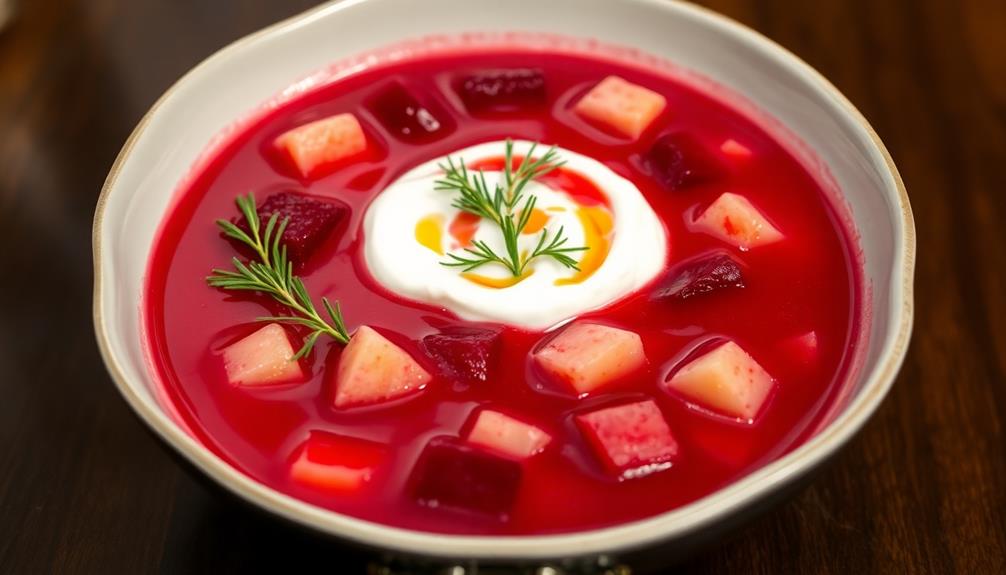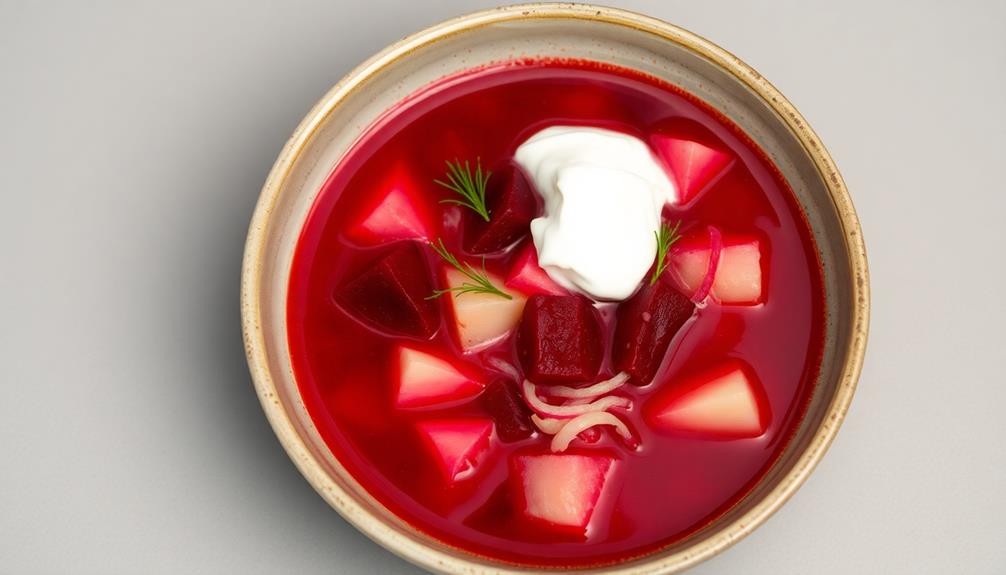Borscht is a vibrant and hearty beet soup with roots deep in the culinary traditions of Eastern Europe. It's a beloved symbol of regional heritage and hospitality, often featured at family gatherings and celebrations. You'll find unique recipes across Ukraine, Russia, Poland, and Romania, each reflecting the local ingredients and customs. The key flavors come from sweet beets, tangy vinegar, and savory broth, with added touches of garlic, dill, and sour cream. Not only is borscht delicious, but it's also packed with nutrients from the beets. If you'd like to learn more about this comforting cultural staple, keep reading to explore its fascinating history and modern adaptations.
Key Takeaways
- Borscht is a traditional soup originating in Ukraine, with roots tracing back to Eastern Europe, and has become popular across regions with local variations.
- The core ingredients of borscht include beets, cabbage, meat, and are enhanced with garlic, dill, and vinegar for a balance of sweet, tangy, and savory flavors.
- Borscht is a vibrant and hearty soup that can be served hot or chilled, and is often associated with cultural traditions and family gatherings in Eastern Europe.
- Borscht is nutritious, rich in vitamins, antioxidants, and fiber, and can be adapted to be low in calories, making it a healthy meal option.
- Modern adaptations of borscht have embraced fusion variations, vegan and gluten-free options, reflecting its versatility and continued relevance in contemporary cuisine.
History
Borscht's origins can be traced back to the Ukraine, where it first emerged as a simple peasant dish centuries ago.
Over time, this hearty beet soup spread throughout Eastern Europe, becoming a beloved staple in countries like Russia, Poland, and Romania.
As borscht evolved, cooks began experimenting with different ingredients and preparation methods. Some versions featured meat, while others remained vegetarian.
Some were served hot, while chilled borscht became popular on hot summer days. No matter the variation, borscht always centered around the humble beet, which lent its signature deep-red color and earthy, sweet flavor.
Today, borscht is enjoyed around the world, a testament to its enduring popularity.
Whether it's a family recipe passed down for generations or a contemporary take on a classic, this beloved soup continues to nourish and delight.
Its rich history and diverse flavors make borscht a true culinary treasure of Eastern Europe.
Recipe
Borscht is a beloved Ukrainian soup that showcases the vibrant color and earthy flavor of beets. This hearty, nourishing dish is a comforting staple, often served with a dollop of sour cream or a slice of rye bread. Some variations of borscht include added ingredients such as potatoes, carrots, cabbage, and even meat, such as beef or pork. Although borscht is generally associated with Ukrainian cuisine, it is also popular in Russian cuisine, with a traditional Russian borscht recipe often including a wider variety of vegetables and a richer, more savory flavor profile. The dish has become popular in many countries around the world, with each region adding its own unique twist to the classic recipe.
The key to a delicious borscht lies in the balance of sweet beets, tangy vinegar, and savory broth. Each region and household has its own variation, but the core ingredients remain the same – beets, onions, and a flavorful stock.
Ingredients:
- 1 lb beets, peeled and diced
- 1 onion, diced
- 3 cloves garlic, minced
- 4 cups vegetable or beef broth
- 2 tablespoons red wine vinegar
- 1 teaspoon sugar
- Salt and pepper to taste
- Sour cream, for serving (optional)
Instructions:
In a large pot, sauté the onion and garlic in a bit of oil over medium heat until translucent.
Add the diced beets and pour in the broth. Bring the mixture to a boil, then reduce the heat and simmer for 30-40 minutes, or until the beets are tender.
Stir in the red wine vinegar and sugar, and season with salt and pepper to taste.
Ladle the borscht into bowls and serve with a dollop of sour cream, if desired.
For optimal flavor, allow the borscht to sit for 30 minutes to an hour before serving, as this allows the flavors to meld.
The borscht can be made a day in advance and reheated before serving.
Additionally, try adding shredded cabbage, diced potatoes, or cooked beans to make the soup even heartier.
Cooking Steps
Peel and dice those beets, then sauté the onions and garlic in a pot.
Next, pour in the stock and let it all simmer until the beets are tender.
Step 1. Peel and Dice Beets
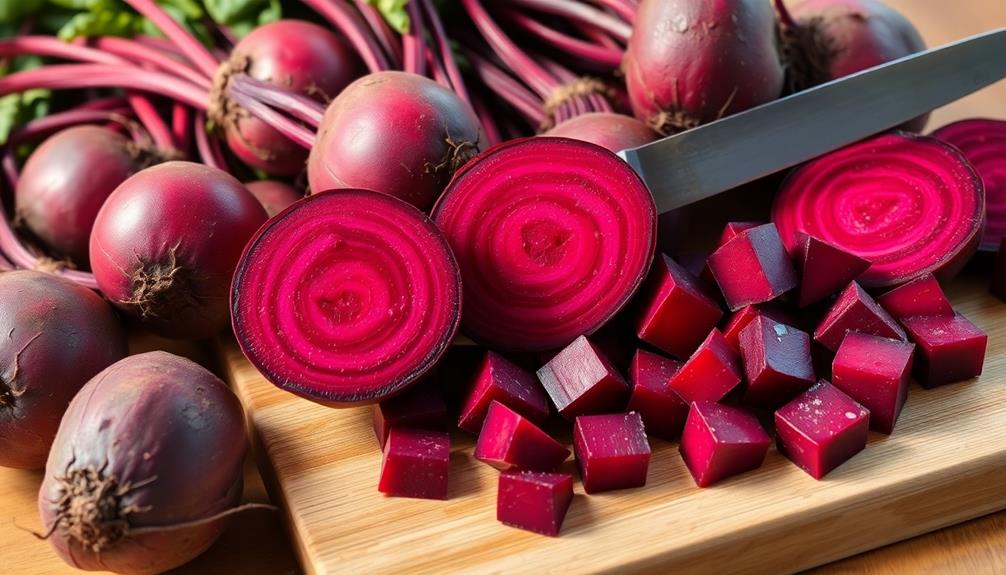
First, grab a sturdy vegetable peeler and remove the skin from the beets. You'll want to peel them down to the vibrant, deep-red flesh underneath. Go slowly and carefully to avoid cutting yourself.
Once they're peeled, it's time to dice them up. Grab a sharp knife and slice the beets into thin, uniform pieces. This will help them cook evenly in the pot. Aim for cubes that are about 1/2-inch thick.
As you work, try to keep the pieces a similar size so they'll cook at the same rate. Don't worry if they're not perfect – a little variation is okay. Just focus on getting them diced up nice and small.
Once all the beets are peeled and chopped, you're ready to add them to the pot and get this borscht cooking! Just wait until you see that gorgeous purple color start to emerge. It's going to be delicious.
Step 2. Sauté Onions and Garlic
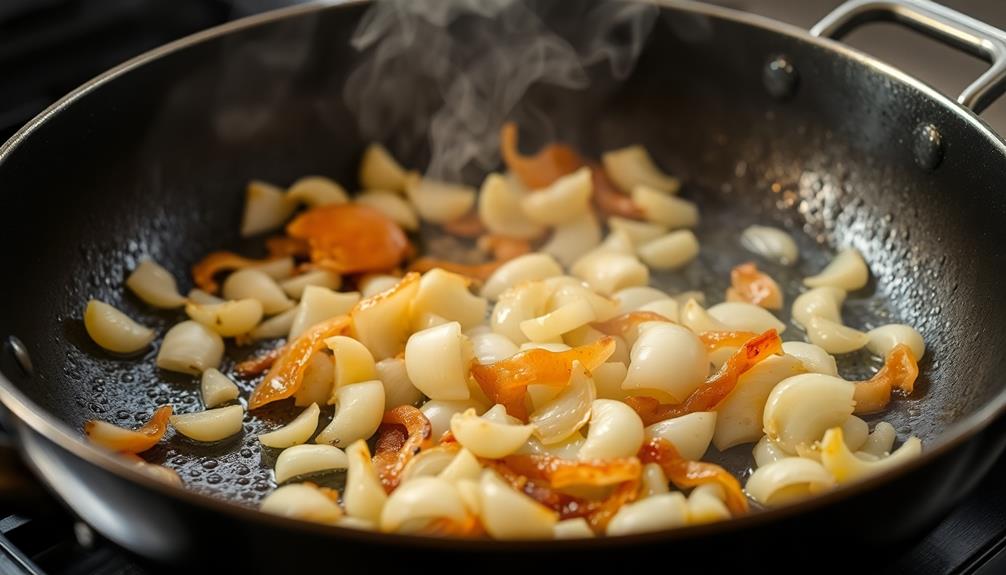
Next, grab a large pot or Dutch oven and heat a drizzle of olive oil or vegetable oil over medium heat.
Once the oil is shimmering, it's time to add the onions. Toss them in and let them sizzle, stirring occasionally, until they become soft and translucent, about 5 to 7 minutes.
Don't rush this step – the onions need time to develop their sweet, caramelized flavor.
Now, it's garlic's turn to join the party. Mince or press a few cloves of garlic and add them to the pot.
Let the garlic cook for about a minute, just until it becomes fragrant.
Be careful not to let it burn, as that can make the flavor bitter.
The combination of softened onions and aromatic garlic will create a delightful base for your borscht.
Step 3. Add Stock and Simmer
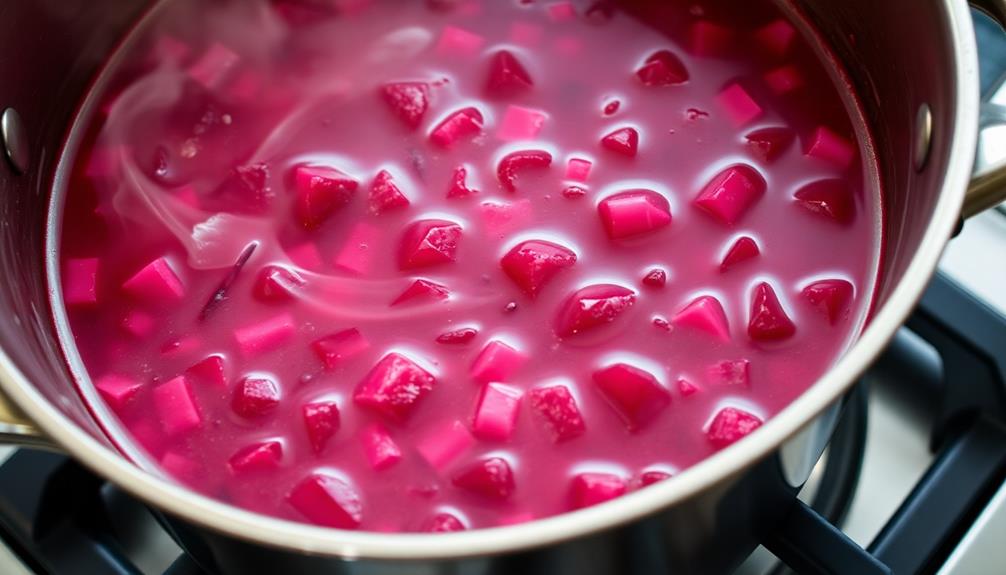
With the onions and garlic sizzling away, it's time to add the stock. Grab your favorite broth – whether it's chicken, beef, or vegetable – and pour it right into the pot.
The key is to use a flavorful, high-quality stock that will infuse your borscht with tons of savory goodness. Give everything a good stir, making sure to scrape up any browned bits from the bottom of the pan.
Now it's time to let the magic happen! Reduce the heat to medium-low and let the soup simmer gently for about 30 minutes. This allows the flavors to meld and the beets to become meltingly tender.
Keep an eye on it, giving an occasional stir to prevent sticking. The rich, ruby-red color of the beets will slowly diffuse into the broth, transforming it into a vibrant, deeply flavored soup.
Get ready for your kitchen to be filled with the heavenly aroma of this comforting beet-based delight!
Step 4. Add Sour Cream and Dill

Once the borscht has simmered and the beets are tender, it's time to finish the dish with a couple of signature toppings.
First, grab a dollop of cool, creamy sour cream and swirl it right into the hot soup. The tangy creaminess balances the earthy sweetness of the beets perfectly.
Next, sprinkle some fresh, fragrant dill over the top. The bright, herbal notes of the dill add a lovely contrast to the deep, vibrant color of the borscht.
The dill's delicate fronds dance lightly on the surface, inviting you to take a big, satisfying spoonful.
These simple toppings transform the borscht from a hearty, rustic soup into a truly indulgent and comforting dish.
The cool, tangy sour cream and the fresh, aromatic dill elevate the beets' natural flavors, making every bite a delightful experience.
Get ready to enjoy the very best of Eastern European cuisine!
Step 5. Serve With Crusty Bread
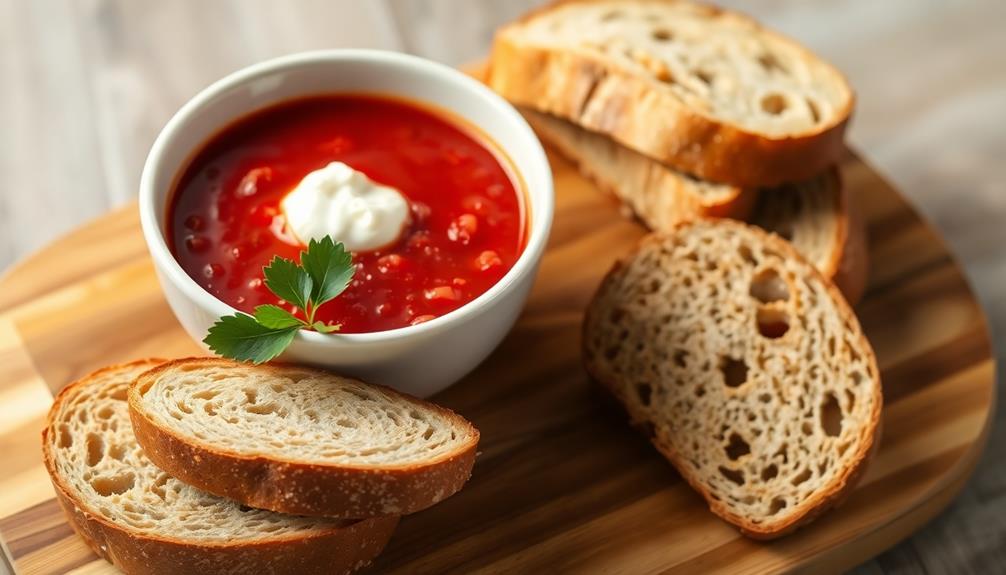
A crusty loaf of bread is the perfect companion to soak up every last drop of the rich, velvety borscht. As you ladle the steaming soup into your bowl, tear off a hunk of that warm, crusty bread. Dunk it in, letting the tangy, earthy flavors of the borscht soak into the bread.
The contrast of the crisp crust and soft interior creates a delightful texture that complements the borscht beautifully. The bread acts as an edible spoon, helping you enjoy every morsel. Its hearty, rustic flavor stands up to the boldness of the beet soup.
Plus, it provides a satisfying chew to balance the velvet-smooth texture of the borscht. Whether you choose a crusty artisan loaf or a simple homemade roll, the bread elevates the entire dining experience.
Serve it alongside the borscht and let your guests revel in the perfect pairing. The crusty bread makes this Eastern European classic even more comforting and complete.
Final Thoughts
Embracing the bold flavors of borscht, this hearty beet soup stands as a testament to the culinary traditions of Eastern Europe. As you've discovered, this vibrant dish isn't just a simple soup – it's a cultural experience, a celebration of the region's rich heritage and the produce it so abundantly provides.
Borscht's versatility is a true delight. Whether enjoyed hot or chilled, with a dollop of sour cream or a sprinkle of fresh dill, the symphony of flavors always satisfies. It's a dish that can be savored year-round, offering comfort in the colder months and refreshment when the weather is warm.
As you bid farewell to this culinary adventure, remember that borscht is more than just a meal – it's a gateway to a world of flavors and traditions that have been passed down for generations.
Frequently Asked Questions
What Is the Nutritional Value of Borscht?
The nutritional value of borscht is impressive. It's high in vitamins A and C, fiber, and antioxidants. The beets provide folate, manganese, and potassium. Plus, it's low in calories, making it a healthy and satisfying soup.
How Long Can Leftover Borscht Be Stored?
Leftover borscht can be stored in the refrigerator for 3-4 days or in the freezer for 2-3 months. Make sure to store it in an airtight container to prevent spoilage and maintain its fresh flavor.
Can Borscht Be Frozen for Later Use?
You can definitely freeze borscht for later use. Once cooled, transfer it to airtight containers or freezer bags and store in the freezer for up to 6 months. Thaw in the refrigerator before reheating and serving.
What Are Some Common Garnishes for Borscht?
You can garnish your borscht with sour cream, chopped hard-boiled eggs, fresh dill, crumbled bacon, or grated horseradish. These toppings add flavor and texture, enhancing the overall experience of this vibrant, traditional soup.
Is Borscht Suitable for Vegetarians or Vegans?
Yes, borscht can be suitable for vegetarians and vegans. The traditional recipe uses beets, vegetables, and herbs, so it can easily be made without any meat or dairy products.
